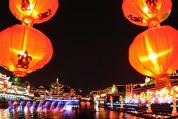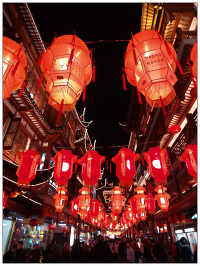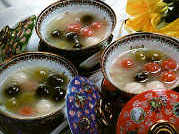
China Overview
- Population: 1.3 billion
- Currency: yuan
- Guinness World Records: most people painting each other's faces simultaneously in one location (13,413), largest bottle of cooking oil (containing 3212 litres), most couples hugging (3009 couples).
- Internet users: 135 million
- Milk beer: from Inner Mongolia, an alternative to the traditional mare's-milk wine.
- Squirrel fish: whole mandarin fish deep-fried and manipulated to resemble a squirrel.
- Number of chinese characters: over 56,000
Lantern Festival
Lantern Festival is on the 15th day of the 1st lunar month, the first night to see a full moon. The first lunar month is called “Yuan” month and in the ancient times people called night “Xiao”. So the day is also called “Yuan Xiao Festival” in China. According to the Chinese tradition, at the very beginning of a new year, when there is a bright full moon hanging in the sky, there should be thousands of colorful lanterns hung out for people to appreciate. At this time, people, getting all their families united, will guess lantern riddles and eat “Yuan Xiao” (glutinous rice ball). |
What is the history of Lantern Festival? | |
| There are many different beliefs about the origin of the Lantern Festival. It had something to do with religious worship. One legend tells us that it was a time to worship Taiyi, the God of Heaven in ancient times. The belief was that the God of Heaven controlled the destiny of the human world. He had sixteen dragons at his beck and call and he decided when to inflict drought, storms or pestilence upon human beings. |
Another legend associates the Lantern Festival with Taoism. Tianguan is the Taoist god responsible for good fortune. His birthday was on the 15th day of the first lunar month. It is said that Tianguan likes all types of entertainments. So followers prepare various kinds of activities during which they pray for good fortune. | |
The third story was related to Buddhism. Buddhism first entered China during the reign of Emperor Ming of Eastern Han Dynasty in 1th Century BC. It was said that Emperor Ming had a dream about a gold man in his palace. He was about to ask the mysterious figure who he was, but the gold man suddenly rose to the sky and disappeared in the west. The next day, Emperor Ming sent a scholar to India on a pilgrimage to locate Buddhist scriptures. After journeying thousands of miles, the scholar finally returned with the scriptures. |  |
Emperor Ming ordered that a temple be built to house a statue of Buddha and serve as a repository for the scriptures. Followers believe that the power of Buddha can dispel darkness. So Emperor Ming ordered his subjects to display lighted lanterns during what was to become the Lantern Festival. Until the Sui Dynasty in the 6th century, Emperor Yang invited envoys from other countries to China to see the colorful lighted lanterns and enjoy the gala performances. | |
What do people eat on Lantern Festival? | |
| Besides entertainment and beautiful lanterns, another important part of the Lantern Festival is eating Yuanxiao, as Latten Festival is also called as “Yuanxiao Festival”. It is also called “Tangyuan”, which has the same pronunciation as “Tuanyuan”, meaning reunion. People thus eat them to denote union, harmony and happiness for the family. It is said that the custom of eating Yuanxiao was originally from the Eastern Jin Dynasty in the 4th century. It then became popular during the Tang and Song periods. |
Yuanxiao is a kind of small dumpling balls made of glutinous rice flour. The fillings inside the Yuanxiao are either sweet or salty. Sweet fillings are made of sugar, Walnuts, sesame, osmanthus flowers, rose petals, sweetened tangerine peel, bean paste, or jujube paste. The salty variety is filled with minced meat, vegetables or a mixture. A single ingredient or any combination can be used as the filling. | |
All Topics about China
- General-China-Introduction
- C2-Chinese-History
- Chinese-Religions
- Chinese-Food-and-Drink
- Chinese-Literature
- Chinese-Nationality
- Chinese-Architecture
- Chinese-Arts-and-Crafts
- Chinese-Language-and-Education
- Chinese-Medicine
- Chinese-Transportation
- Chinese-Festival
- Chinese-Astrology-and-Zodiac
- Chinese-Calendar
- Chinese-Traditional-Sports-&-Activities
- Chinese-Martial-Arts
HOTMost Popular Topics
Climate in China
Because of its size, China has great climatic diversity. Generally, the best time to visit China is during spring and autumn.
Chinese-Language-and-Education
Chinese is the most commonly used language in China, and one of the most commonly used languages in the world.
Chinese-Festival
China has many traditional festivals, including the Spring Festival, the Lantern Festival, the Dragon Boat Festival.
Chinese Chinese-Astrology-and-Zodiac
In the Chinese zodiac, twelve animals are used to denote the year of a person's birth: rat, ox, tiger, rabbit, dragon.
History of China
China, one of the world's most ancient civilizations, has a recorded history of nearly 4,000 years..









